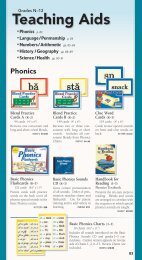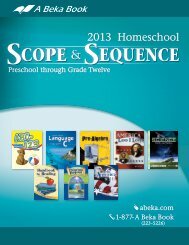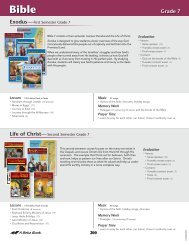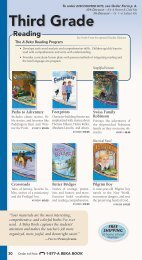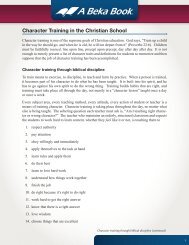ABB School Scope and Sequence 2012- Sixth Grade ... - A Beka Book
ABB School Scope and Sequence 2012- Sixth Grade ... - A Beka Book
ABB School Scope and Sequence 2012- Sixth Grade ... - A Beka Book
You also want an ePaper? Increase the reach of your titles
YUMPU automatically turns print PDFs into web optimized ePapers that Google loves.
15740602<br />
6 6<br />
Fourth Edition<br />
´/j&"x¨<br />
<strong>Sixth</strong> <strong>Grade</strong><br />
Science<br />
Observing God’s World is an excellent bridge between elementary <strong>and</strong> junior high or<br />
middle school science. This memorable text presents the universe as the direct creation<br />
of God <strong>and</strong> refutes the man-made idea of evolution.<br />
Observing God’s World features photos, art, <strong>and</strong> charts that clearly illustrate the science<br />
concepts being taught. Students will apply what they have learned by doing projects<br />
<strong>and</strong> experiments both at home <strong>and</strong> at school. Some of the topics students will study<br />
include invertebrates, plants, forces of the earth, the universe, space travel, <strong>and</strong> matter<br />
<strong>and</strong> chemistry.<br />
RED indicates first introduction of content.<br />
Added Enrichment<br />
••<br />
Worksheets (24) including:<br />
labeling diagrams, identification,<br />
chapter content review<br />
••<br />
Suggested:<br />
••<br />
Review games (13)<br />
••<br />
DVDs (2)<br />
••<br />
Adopt-a-Tree poster<br />
••<br />
Astronomy report<br />
Evaluation<br />
••<br />
Printed quizzes (25)<br />
••<br />
Homework quizzes (9)<br />
••<br />
Tests (8)<br />
••<br />
9-weeks exam (3)<br />
Plants<br />
••<br />
Leaves:<br />
hhPhotosynthesis in detail, leaf anatomy, tendrils, spines, bulbs,<br />
insectivorous plants<br />
••<br />
Roots <strong>and</strong> stems:<br />
hhShoot system, taproot, root cap, root hairs<br />
hhEpiphytes, cellulose, cell wall<br />
hhStolon or “runner,” rhizomes, thorns<br />
••<br />
Flower, fruit, <strong>and</strong> seed:<br />
••<br />
Flower structure:<br />
hhBud, bracts, ovary, ovules, stigma<br />
hhProcess of fertilization<br />
••<br />
Fruits:<br />
hhDevelopment <strong>and</strong> scientific definition<br />
••<br />
Conditions for seed growth<br />
••<br />
Seed structure:<br />
hhCotyledons<br />
hhHybrid<br />
••<br />
Plant families you should know:<br />
••<br />
Composite family<br />
hhPea, rose, lily, grass families:<br />
hhCereal grass, turf grass, woody grass<br />
••<br />
Trees:<br />
hhPerennials, annuals, biennials<br />
••<br />
Notable trees:<br />
hhCalifornia redwood<br />
hhBanyan, c<strong>and</strong>lewood, <strong>and</strong> baobab trees<br />
••<br />
Bristlecone pine<br />
hhCambium, tree bark<br />
••<br />
Annual growth rings<br />
••<br />
Broadleaf trees:<br />
hhHardwoods<br />
••<br />
Deciduous<br />
••<br />
Selected broadleaf trees:<br />
••<br />
Maples, elms oaks:<br />
hhSpecific examples, Dutch elm disease<br />
hhBirches, willows: specific examples<br />
••<br />
Conifers:<br />
hhTypes of cones, conifer pollination<br />
hhCharacteristics contrasted with broadleaf trees<br />
••<br />
Evergreens<br />
95<br />
••<br />
Selected conifers:<br />
••<br />
Pines, hemlocks, firs, spruces:<br />
hhSpecific examples<br />
hhDouglas firs<br />
hhLarches: tamarack<br />
hhRedwoods: giant sequoia, General Sherman tree, bald cypress,<br />
knees<br />
hhCypresses: cedars, junipers, western red cedar, cedar of Lebanon<br />
••<br />
Palms:<br />
hhFronds<br />
••<br />
Coconuts<br />
••<br />
Plant surprises:<br />
••<br />
Ferns:<br />
••<br />
Spores<br />
hhFern anatomy: spore cases, rhizoids, fronds<br />
hhTree fern<br />
••<br />
Mosses:<br />
hhMoss anatomy<br />
hhPeat moss<br />
••<br />
Algae:<br />
hhDiatoms, diatomite, dinoflagellates, flagella, filamentous algae<br />
••<br />
Seaweeds: blades, air sacs, holdfasts<br />
••<br />
Kelp<br />
hhAlgin<br />
••<br />
Carrageenan<br />
••<br />
Fungi:<br />
hhSaprophytes<br />
••<br />
Parasites<br />
hhMycelium, hyphae<br />
••<br />
Molds <strong>and</strong> mildews:<br />
hhStructure <strong>and</strong> characteristics<br />
••<br />
Penicillin<br />
••<br />
Mushroom:<br />
hhStructure: fruiting body<br />
••<br />
Yeast<br />
hhSlime molds, lichens<br />
Activities & Demonstrations:<br />
hhRecognizing leaf shapes<br />
hhColoring carnations<br />
hhDemonstrating tropism in plants<br />
hhDissecting a flower<br />
hhMaking bark rubbings<br />
hhWorking with yeasts<br />
hhHunting mushrooms<br />
••<br />
Producing bread mold spores<br />
Science cont. p. 96<br />
© A <strong>Beka</strong> <strong>Book</strong>








